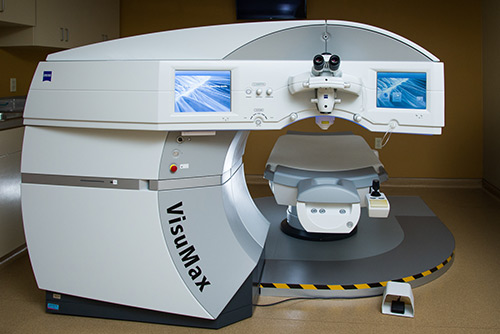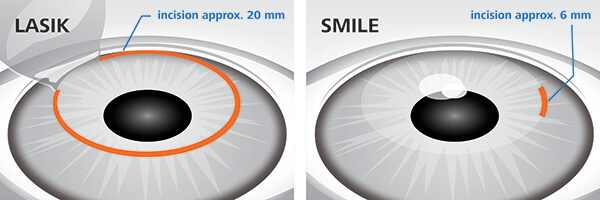The Cataract Surgeons

SMILE Visumax Eye Correction
SMILE®, also known as third-generation Laser Vision Correction, is a state-of-the-art procedure that is less invasive, has minimal downtime, and less discomfort. This procedure is perfect for people who suffer from nearsightedness with astigmatism but do not qualify for traditional LASIK. SMILE® is a LASIK-like procedure available to improve their vision with all of the benefits of traditional LASIK. As the refractive eye-care experts, The Cataract Surgeons are the only specialists with the technology to offer SMILE® in Louisiana!
What Are the Benefits of SMILE®?
Because SMILE® relies on a single 4mm incision, it is less invasive than traditional LASIK. With the incision being so much smaller than what is required in other Laser Vision Correction procedures, our team can preserve the cornea’s integrity, and post-op dry eye is significantly reduced. Because the procedure can be completed quickly and has few risks associated with it, many patients who are not eligible for traditional LASIK qualify for SMILE®.
SMILE vs LASIK: What Is the Difference?
The SMILE® procedure was designed primarily to improve eyesight for patients who struggle with Myopia with astigmatism, commonly called nearsightedness. While traditional LASIK requires the use of two separate lasers, SMall Incision Lenticule Extraction, aka, SMILE®, improves Myopia with the use of a single ReLEx SMILE® laser. This procedure uses a special laser to create a thin, contact lens-shaped layer just beneath the eye’s surface and then a small 4mm opening, through which the layer is removed. By removing the layer of tissue, the cornea is reshaped, which instantly improves the patients’ vision.
This makes SMILE a relatively streamlined procedure when compared to LASIK. The latter eye surgery requires two lasers, one of which cuts the patented LASIK “flap” into the eye’s top layer. This incision is much larger than the one needed for SMILE eye surgery. Due to the less invasive cut used in SMILE, the recovery period is much shorter than the one for LASIK and comes with the bonus of less dry eye.

Can SMILE Eye Surgery Help Your Astigmatism?
Astigmatism is one of the most common eye conditions in the country. It affects the shape of the cornea, the outermost lens of the eye. Typically, your cornea should resemble a sphere. Those with astigmatism, though, have a cornea that looks more oblong, similar to a football. When your cornea is misshapen like that, you’ll have difficulty discerning details in objects at near and far distances. That is, specific objects may look blurry.
This eye condition can affect people with both nearsightedness or farsightedness. Currently, SMILE eye surgery is only approved to help those with astigmatism dealing with nearsightedness, also known as myopia.
The history of SMILE eye surgery for those with myopic astigmatism dates back to 2011. The discovery of this new way to treat nearsightedness is considered one of the most considerable eye surgery advances within the past decade.
Its approval on the global stage helped hundreds of thousands of people worldwide improve their vision. After years of study on the procedure’s safety and efficacy, it was approved by the Federal Drug Administration for use within the United States to treat or eliminate myopia in 2016. Two years later, the FDA also approved it for use in treating those dealing with a combination of myopia and astigmatism.
How Can You Avoid Dry Eye With SMILE?
If you know someone who has gone through LASIK, you’ve probably heard their complaints about the long period of post-op dry eye that they’ve experienced. In some cases, this side effect of the procedure can last up to a year. Those who are typically situated in front of a screen are most likely to be affected.
This long period of dry eye was due to the large incision required by the operation. When making the incision, the nerve of the eye that detects moisture levels can be damaged. While they do regenerate, you’ll probably experience at least some dry eye until they come back.
However, because SMILE only needs a small incision, the severity and intensity of the damage to the dryness-detecting nerves are more likely to be minimal. This means you’ll have a shorter recovery period with less intense periods of dry eye, even if you live in a dry climate.
The shorter recovery period is born out in both anecdotal and scientific research related to the two procedures. So, the best way to avoid a prolonged dry eye period post-procedure is to receive SMILE eye surgery instead of LASIK.
Who Is a Good Candidate For SMILE Eye Surgery?
Another benefit of the smaller incision made during SMILE eye surgery is that the procedure’s candidate pool is larger than with LASIK. However, it is not approved for all eye issues. As stated above, in the United States, it’s approved for those dealing with myopia or myopic astigmatism. Specifically, SMILE eye surgery can correct nearsightedness up to –10.00 diopters and astigmatism up to –3.00 diopters. If your myopia or astigmatism falls those boundaries, you will need a different procedure or treatment.
Still, even those with myopia or myopic astigmatism may not be approved for the surgery. Generally, you will need to meet some basic qualifications to be considered a candidate:
- Be at least 22 years old
- Generally good health
- Have a consistent eye prescription that has lasted for at least a year
- Neither pregnant nor nursing
- No history of eye disease
If you’re struggling with myopia or myopic astigmatism and meet these qualifications, then you should request an appointment with our doctors. They are best equipped to examine your eyes and health history to determine if you are a good candidate for SMILE eye surgery.
SMILE Eye Surgery Recovery
Smile eye surgery is safe and effective with a short recovery period. The majority of patients report their vision has improved by at least 80% within a few hours of the surgery’s completion, and most patients report their nearsightedness or astigmatism is eliminated with only a week or two of recovery.
This short recovery period means you can quickly resume your typical daily routine. Many patients only need a single week to return to physical activities, including strenuous ones like swimming or contact sports.
You should do your best to avoid screens as much as possible for the first few days after the procedure. This helps your eyes rest and prevents straining that may lengthen the recovery process. Your doctor may also prescribe medications or eye drops in the event of dry eye.



